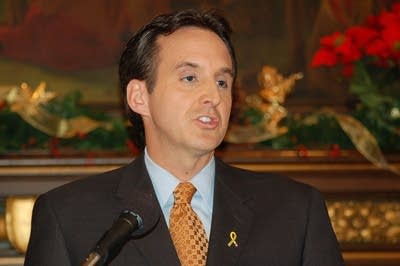Gov. and legislature largely in agreement on health care changes

The leading health care reform proposal this year is based on the work of two task force groups. One represented the governor. The other was established by the Legislature. After months of work last summer and fall, both task forces recommended essentially the same plan.
They propose altering the health care payment system in Minnesota from one that rewards doctors for treating sick patients to one that rewards physicians for preventing illnesses. The payment change alone they say could save millions of dollars each year on health care.
Those savings are key to holding down rapidly rising insurance costs, says Gov. Tim Pawlenty. During a news conference last week the governor said the savings could then be tapped to expand coverage and make it more affordable.
"It is our hope that if those savings can be realized and identified and accounted for, that then they can be re-deployed with the goal of trying to contain premiums, costs of premiums and insurance and health care for people as well as expanding access to the uninsured."
Create a More Connected Minnesota
MPR News is your trusted resource for the news you need. With your support, MPR News brings accessible, courageous journalism and authentic conversation to everyone - free of paywalls and barriers. Your gift makes a difference.
But the governor also said he wants to see the savings first, before the state spends more money on expanding health care coverage to all Minnesotans.
Saving money should be a priority, says Rep. Tom Huntley, DFL-Duluth, who chairs a health care finance committee. But he says that doesn't mean lawmakers should do nothing for the uninsured while they wait for the savings to roll in.
"I would just as soon start the expansion of eligibility a little sooner. We do have a surplus right now in the Health Care Access Fund. I think we could use that to get started and expand MinnesotaCare and we will be debating that during the session."
The Health Care Access Fund surplus is estimated to reach approximately $300 million. Huntley says since the surplus comes from a tax on providers it's only appropriate to spend the money on health care - not to balance the budget as some other lawmakers have suggested.
But Huntley also says he doesn't anticipate any insurmountable battles on health care reform this session. He says Democratic leaders and the governor both want to get something done.
"There are a great deal of similarities between his view and our view. You know he has to sign the bill and I want to have a bill that he will sign and will go into effect."
That doesn't mean it will be easy. Huntley says he's expecting push back from some providers and health plans who will have to make big changes in how they deliver and pay for care. The Minnesota Medical Association, which represents the majority of the state's doctors, does have some concerns about the payment reform proposal.
Most doctors and hospitals aren't in a position to absorb the cost of care that might exceed the new payment reform system, says MMA executive director, Bob Meiches.
"What we don't want is a situation where physicians and hospitals and other providers can't do what they think is indicated because they are taking the financial risk."
In general though the MMA agrees with most of the steps lawmakers are proposing in the reforms - particularly measures that would extend insurance coverage to more Minnesotans and promote healthier lifestyles, Meiches says.
Still there's no guarantee health care reform will materialize this session. One lawmaker told MPR that at the end of the day, he thinks the reform battle will hinge more on attitude than partisan politics. He says the question many lawmakers will ask themselves is whether this is an issue that needs to be solved right now or can it wait another year?
